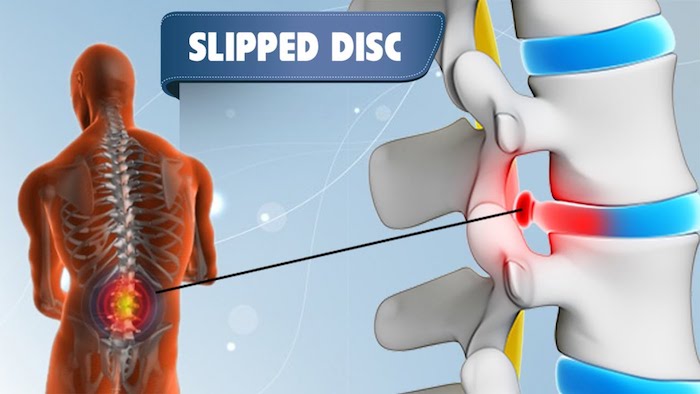
A slipped disc refers to an intervertebral disc of the spine that has lost its normal shape and/or consistency. The altered shape occurs when the disc’s soft inner material (nucleus pulposus) bulges or leaks out of its external fibrous covering (annulus fibrosus). Several medical terms, such as herniated, ruptured, torn, bulged, or protruding disc may be used interchangeably with a slipped disc.
Your intervertebral discs are spinal shock absorbers and help transfer loads evenly. When a slipped disc occurs, the entire motion segment—including the adjacent vertebrae, connective tissue, blood vessels, and nerves may be affected. Slipped discs are more common in the lower back, followed by the neck.
How A Slipped Disc Occurs
The two most common causes of a slipped or herniated disc are:
- Natural degeneration of the disc, causes the nucleus pulposus to become less hydrated and weaken with age.
- Trauma to the disc may occur due to lifting a heavy load using incorrect posture or from external forces, such as a whiplash injury.
Rarely, disorders of the connective tissue of the spine or alterations in the shape of the spinal vertebrae, such as short pedicles, may cause a slipped disc to occur.
Contained Vs. Uncontained Discs
When the nucleus pulposus of a slipped disc leaks into the tears of the annulus fibrosus but does not exist beyond the disc’s outermost layer, it is called a contained disc.
If the nucleus pulposus leaks outside a disc completely, it is called an uncontained disc.
Types of Pain from A Slipped Disc
A slipped disc may cause pain within the local area, such as your neck or back, or in a distant location, such as your arm and/or leg.
Some slipped discs may not cause pain. It is possible for a herniated disc to be painless and/or spontaneously resolve itself without treatment.
Nerve Pain
Herniation commonly occurs toward the side and back of the disc, where the annulus fibrosis is relatively thinner. This part of the disc is also close to the spinal nerve roots and can cause:
- Mechanical compression of these nerve roots may result in nerve pain and/or weakness in your arm or leg, depending on the site of compression
- Chemical irritation of the nerve roots due to the leaking of inflammatory substances from the nucleus pulposus
In severe herniation of the disc, spinal cord, or cauda equina compression may occur.
Chronic Localized Pain
A slipped disc may cause localized, chronic pain, such as lower back pain or neck pain. This type of pain is also called discogenic pain.
Motion Segment Instability
A slipped disc due to degeneration may cause instability in the spinal motion segment, resulting in pain and abnormally increased or decreased mobility.
The Importance of a Correct Diagnosis
A doctor can accurately diagnose a slipped disc and rule out other causes of similar pain, such as tumors, fractures, or infection. A correct diagnosis also helps formulate an effective treatment plan to control your symptoms and prevent the progression of nerve or spinal cord damage.
Precision Pain Care and Rehabilitation has two convenient locations in Richmond Hill – Queens and New Hyde Park – Long Island. Call the Richmond Hill office at (718) 215-1888, or (516) 419-4480 for the Long Island office, to arrange an appointment with our Interventional Pain Management Specialist, Dr. Jeffrey Chacko.













